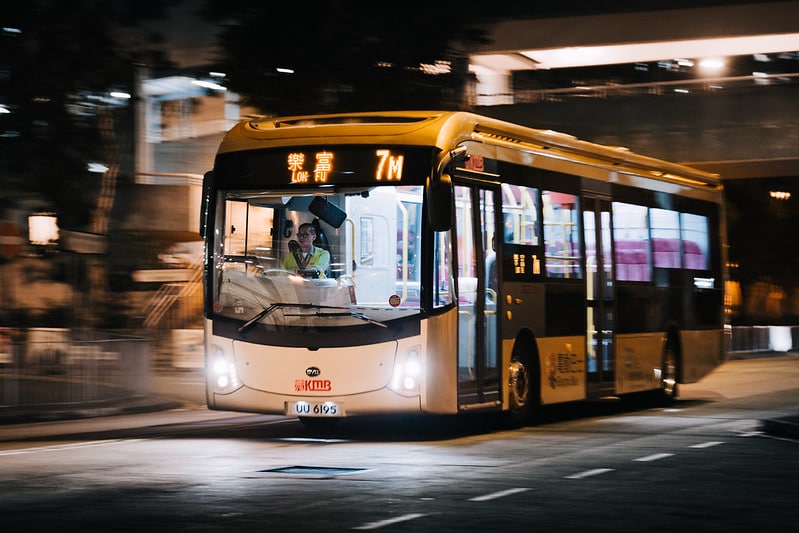In her 2020 Policy Address, Hong Kong Chief Executive Carrie Lam outlined the city’s 2050 carbon neutrality target. The government recognises that achieving carbon neutrality will require a variety of measures, including expanding local renewable energy, improving energy efficiency in the building sector, promoting low-carbon mobility and improving waste management. This is the second article in a series of articles that takes a closer look at individual elements needed to achieve the “Carbon Neutrality 2050” target in Hong Kong – this time with a focus on promoting electric vehicles and low-carbon waterborne mobility.
—
Transitioning away from our present transportation system may well be one of this generation’s most difficult tasks. In general, electric mobility plays an important role in this transition, as electric vehicles operate more efficiently than vehicles with internal combustion engines and rely on electricity that can be sourced sustainably. Transit Jam estimates that if every vehicle in Hong Kong were an electric vehicle (and assumed to travel with the same energy efficiency as the 2018 fleet average and a 90% charging efficiency), the total carbon footprint for the transportation sector would drop to 1.4 million tons. This is equivalent to only 19% of the current 7.35 million tons. As a result, many countries and organisations have introduced EV-roadmaps. However, the adoption of electric mobility is still relatively slow, as is the case in Hong Kong.
The potential is, however, evident – or as Tesla CEO Elon Musk said at a Tesla event in Hong Kong in early 2016: “Hong Kong will be the city with the highest share of electric vehicles in the world and can therefore serve as a model for other cities with high population density on the way to a sustainable future.” In terms of new registrations, electric vehicles in Hong Kong accounted for 6.3% of all new registrations of private cars in 2019 (2 423 out of a total of 38 309 newly registered private cars). In order for this figure to increase, and especially for other forms of electric mobility such as electric commercial vehicles or electric ferries to be increasingly adopted, a number of elements must be addressed:
- The government as a role model:
Of the total 6 604 vehicles in the city’s public fleet, 224 are electric vehicles. By adapting the procurement guidelines in all departments, electric mobility could be given a priority – for example by introducing a principle that whenever a vehicle is being replaced, it must be switched to electric mobility / low CO2 alternatives wherever possible. Such a policy would have an additional positive side effect: the more electric vehicles are on the road, the greater the awareness and acceptance among the population and the business sector.
- E-mobility push for commercial vehicles:
While electric mobility is growing in the passenger car segment, growth in the commercial vehicle sector is still low. This is problematic because the main source of roadside air pollution in Hong Kong originates from commercial vehicles (including public transport, lorries, taxis, etc.). These types of vehicles account for 95% of the vehicular emissions of respirable suspended particulates and nitrogen oxides in Hong Kong. Hence, increasing the speed of adoption of electric mobility in the commercial sector would not only significantly reduce CO2 emissions, but also improve air quality. Two areas can be identified for an e-mobility push in the commercial vehicles sector: public transport, including taxis and light commercial vehicles up to 7.5 tons. In these two categories there is a viable range of electric vehicles which are close to being economically competitive.
Public transport, including taxis, are predestined for electric mobility: other big cities such as Amsterdam have for example signed covenants with most official taxi organisations with the aim of creating a full electric taxi fleet before 2025 and they are well on track. All the more so for taxis that manage predictable routes such as taxi services to and from airports. This also means that charging infrastructure can be installed at the right place and taxis can charge their vehicles while waiting for new guests at the airport. However, the investment cost of electric taxis and vehicles for public transport such as electric double-decker buses or single-deck electric buses are still higher than their diesel counterparts which, despite lower maintenance and fuel costs of electric vehicles, still has a deterring effect. Here is where a targeted policy would be useful; substantially subsidising the purchase of e-taxis and electric double decker, single-deck and public light buses in order to reduce the barrier of the higher investment costs would help to introduce electric mobility in public transport and improve air quality.
As for the light commercial vehicles, the introduction of a policy providing a full exemption of the first registration tax (FRT) for commercial EVs alongside the incentives which are already in place such as the full profits tax deduction for the capital expenditures on the vehicles in the first year of procurement and the reduced annual vehicle licence fees could increase the attractiveness for local businesses to switch to e-mobility and could at the same time be introduced as a green post-COVID-19 stimulus to support the local economy.
- Electrifying waterborne transport:
Inner city transport in Hong Kong involves not only road traffic but also traffic on its waterways. Norway is in many ways a role model country in terms of electric mobility, particularly on water. Its first electric ferry entered into service in early 2015, crossing the Sognefjord about 34 times a day with a capacity of 360 passengers and 120 cars. The 6 km crossing takes 20 minutes, and the 1 000 kWh Li-ion battery system of the ferry is charged at each quay for about 10 minutes. Hong Kong seems predestined to follow Norway’s success strategy by adopting electric ferries on its many routes, which have similar characteristics as the Norwegian example. It is a proven concept: Norway’s first all-electric ferry has reduced CO2 emissions by 95% and operating costs by 80% – a clear win-win.
You might also like: How Important is Geothermal Power in the World’s Shift to Clean Energy?
- Comprehensive charging infrastructure:
Above all, an adequate charging infrastructure is a central pillar of the success of electric mobility – developments in other countries confirm the importance of a widely developed charging infrastructure. The government can play an important role and ensure that the corresponding infrastructure is developed. In light of the land scarcity and dense population in Hong Kong, establishing a charging network has proven to be more challenging than in other economies. However, things are moving forward; Hong Kong has announced that some 65 000 parking spaces in about 540 car parks will be fitted with EV charging-enabling infrastructure. Additionally, the government is preparing for a HKD$2 billion pilot scheme to subsidise installation of EV charging-enabling infrastructure in car parks of existing private residential buildings. It is encouraging that the Hong Kong government is placing focus on meeting the charging needs for the increasing number of electric vehicles. Apart from encouraging installation of charging infrastructure in new and existing buildings, the government should strengthen its building codes in the sense that new buildings, be they residential or commercial, must necessarily equip their parking spaces with charging infrastructure. One thing is clear: e-mobility charging in Hong Kong will be done either at home or at work.
If the government manages to integrate policies addressing all these elements in its soon-to-be-released EV roadmap, Hong Kong could become a role model for e-mobility while at the same time taking a big step towards its goal of climate neutrality in 2050.
Featured image by: Flickr


















